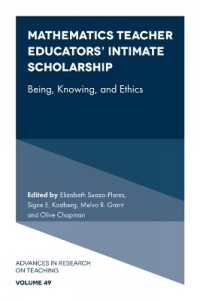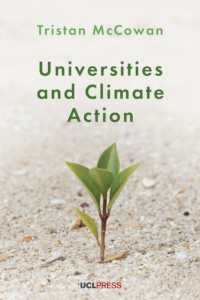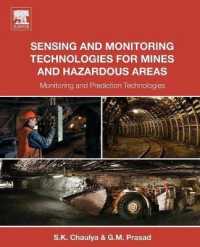Full Description
Provides educators with practical strategies, tools, and techniques for teaching critical reading skills to students in the social and natural sciences.
Strong critical reading skills are an essential part of any student's academic success. Teaching these vital skills requires educators to develop and implement effective teaching strategies, often based on their own critical reading practices. Critical Reading Across the Curriculum, Volume 2: Social and Natural Sciences provides educators with expert insights, real-world methods, and proven strategies to build critical reading skills in students across disciplines. Drawing from the experience of seasoned classroom practitioners, this book presents a dozen essays that offer various applications of critical reading best practices in fields such as anthropology, biology, economics, engineering, political science, and sociology.
Clear, jargon-free chapters identify, explain, and illustrate best teaching practices for critical reading. Containing numerous practical examples and demonstrations, essays written by experts in their respective fields explain what critical reading requires for their discipline, as well as how to teach those skills in the classroom. Every essay includes a host of pedagogical activities, assignments, and projects that can be used directly or adapted for diverse teaching applications. This valuable book helps educators:
Develop the skills students need to ask the right questions, consider sources, assess evidence, evaluate arguments, and reason critically
Encourage students to practice critical reading skills with engaging exercises and activities
Teach students to establish context and identify contextual connections
Explain how to read for arguments, including content-based and conceptual arguments
Adapt and apply teaching strategies to various curricula and disciplines
Critical Reading Across the Curriculum, Volume 2: Social and Natural Sciences is an ideal resource for educators in a wide range of areas, such as college and high school instructors in science and social science disciplines and instructors of graduate education courses.
Contents
Notes on Contributors ix
Preface xiii
Acknowledgments xviii
1 Reading Like an Anthropologist 1
Noelle Molé Liston
Anthropology as Over-the-Shoulder Reading 1
Empathetic Reading 4
Reading for Argument 7
Towards Non-Linear Reading and Representations of Texts 7
Reading for Content-Based Argument versus Conceptual Argument 9
Reading Context as Argument 11
Establishing Context: An Example 12
Reading Media Sources Like an Anthropologist 13
Classroom Activity: Competing Contextual Arguments 16
References 17
2 Developing Proficiency in Economics Through Critical Reading 18
Anna Shostya and Joseph C. Morreale
Economics and Critical Reading 18
Hansen's Proficiencies and Critical Reading 20
Reading as an Economist 21
Concluding Thoughts 38
References 39
3 Searching for Story: Reading in Science 41
Andrea McKenzie and Eric Brenner
Building Reading Skills in High School 43
Reading in the First Year of College and Beyond 45
Reading an Experimental Report 45
From Reading to Writing 55
Notes 56
References 56
4 How to Read a Photograph, a Passport, a Product Sample, and a Patent: Teaching with STEM Archives 58
Lindsay Anderberg
How to Read a Photograph 60
Classroom Implementation and Activities 62
Question Set 1 63
Question Set 2 64
How to Read a Passport 66
How to Read a Product Sample 70
How to Read a Patent 73
Activity Modifications and Student Reactions 76
Question Set 1 for EWP Courses 77
Conclusion 80
References 80
5 Critical Reading in Political Science 81
Michael Busch and Garri Rivkin
What is Critical Reading in Political Science? 82
Teaching Critical Reading in Theory 85
Teaching Critical Reading in Practice 90
6 Minor Data: Reading the "Smart" City Through Engaged Pedagogy 100
Gregory T. Donovan
Reading What is Legible and Illegible in the Smart City 102
Engaging Difference Through Critical Service-Learning 105
Learning and Design Practices 106
Minor Data in Practice: Reading Race in Lincoln Center 111
Conclusion 113
Acknowledgements 114
Notes 114
References 115
7 Critical Reading in Sociology: Developing Confidence to Know the World 117
Jesse Goldstein
Assignment 1: In-Depth Interviews as a Model for Critical Dialogue 118
Assignment 2: Artifact Analysis 121
Assignment 3: Literature Analysis 124
Assignment 4: Reverse Outline 129
Conclusion: Always More Work to Be Done, Never Enough Time to Do It 130
8 Critical Reading in Business Education 132
Robert Lyon
Strategic Critical Reading 133
Strategic Critical Reading in the Social Sciences 136
Conclusion 150
References 151
9 How to Read a Scientific Article: The QDAFI Method of Structured Relevant Gist 152
Pascal Wallisch
Expert and Non-Expert Readers 152
The QDAFI Method: An Overview 154
Benefits of the QDAFI Method 160
A Demonstration 161
Conclusion 163
Acknowledgments 163
References 164
10 A Political Science Pedagogy of Critical Cosmopolitanism 165
Michael S. Rodriguez
Introduction 165
Exercise 1: The Method of Substantiation 166
Exercise 1 Continued: Intellectual Empathy and Tacit Intellectual Wisdom 168
Exercise 2: Global Awareness as Pedagogy 170
Exercise 3: Combining Approaches 172
Theoretical Background 172
The Pedagogy of Cosmopolitanism 174
Conclusion 177
References 177
11 Text(ured) Considerations: Critical Reading in its Digital and Social Contexts 179
Kiersten Greene
Introduction 179
Thinking Aloud 181
Digital Annotation 186
Reading the Room for Equity 190
Final Thoughts 195
References 195
12 Transparency, Encouragement, and Autonomy: Teaching Critically Engaged Reading in Sociology 197
Deborah Gambs
Leveling the Playing Field Through Transparency 199
Encouraging Deep Reading 205
Teaching with Your Mouth Shut 210
Conclusion 212
References 212
13 Critical Reading with STS: Interdisciplinary Inspiration for the Science Classroom 214
Christopher Leslie
Introduction 214
Power and the Social Construction of Science and Technology 218
Darwin and Melville: A Pedagogical Case Study 222
Conclusion 230
References 231
Index 233








